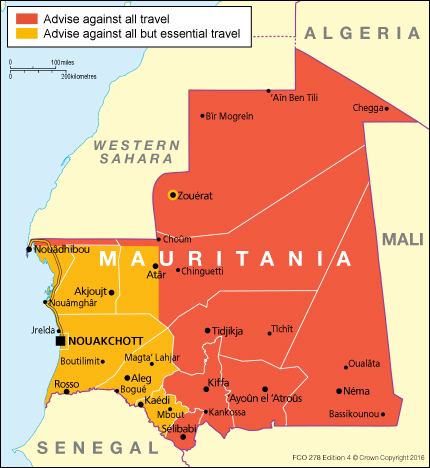This answer was written in 2016 and may be out of date, this answer from 2020 is likely more useful.
This isn't a complete answer, just a summary of what I've found in my research online. Still hoping someone else will post some first-hand experience and win my bounty... In particular this answer is missing how to join a road convoy.
The British governent foriegn office's take on this is essentially:
- The main coastal road is dangerous (their "all but essential travel" yellow warning), but still almost certainly the safest route. They tend to be excessively cautious with such warnings, but such warnings may also invalidate insurance (see this related question for how to get insured if your insurance will be invalidated like this)
- Anywhere in the Eastern desert region (terrorism and kidnappings), and anywhere on the border with Western Sahara except the main road and border (landmines etc) is very dangerous and gets the maximum red "advise against all travel"
They publish a handy map (note the yellow road through the red border area):

The consensus from people who've travelled in Mauritania recently on the Lonely Planet forum seems to be - the military seem to have this "yellow" area under reasonable control, and you should be more wary of scams, hassle and overcharging than kidnappings and terrorism, but be careful, don't take risks and don't draw attention to yourself. Here's one recent report, and here's one poster's recent summary of the consensus (keep in mind that, in an opposite way to officials like the FCO, LP forum posters tend to err towards bravado):
...if you venture out off the beaten track to the east, there are some dangerous elements out that way, possibly, but the military have good control over the main from Western Sahara to the capital, and then down to Senegal. I found it pretty safe walking around when I was there, you never know, but for all the foreigners that pass through the amount of kidnappings over the years is very low. Id still travel low-key if you look obviously western [note that this commenter has an Arabic-sounding username, so their experience might differ to others], but look, Mauritania is not Iraq or Syria.
I haven't yet found any up to date information about how to arrange convoys. If I do, I'll add it in. But there are various people posting about getting good results from shared-taxi-hopping with local drivers.
DriverAbroad.com warn that the Northern stretch of the main road is a kidnapping risk if you're driving your own car. It doesn't give any sources for this information but it matches what I've seen elsewhere, in guidebooks, etc:
There is a significant risk of kidnapping on the road between Nouakchott and Nouadhibou and you shouldn’t contemplate driving this in a self drive care [sic]. The conditions of paved roads in Mauritania is poor, and overland travel is difficult. You are advised to use four wheel drive vehicles, check the tide times, travel in convoy if possible and ensure you take adequate supplies of water and fuel. Local drivers tend to drive without regard to traffic signs or rules. Roadway obstructions and hazards caused by drifting sand, animals, and poor roads are common. These hazards, when combined with the number of untrained drivers , poorly maintained vehicles, and the wider security risk can many Mauritanians drive without regard to traffic signs or rules.
It says to check the tide times because some stretches of coastal roads are under water at high tides. I've read that this is less often true than it used to be (people used to simply use certain long stretches of beach as a main road at low tide), but I can't find a clear source on where exactly this still happens.
It sounds like the golden rule is, avoid situations where you're a westerner(s) on their own in an exposed place, without a decent number of people with local knowledge who you trust around. And also, don't draw too much attention to yourself over a long period. From the US travel advice:
...avoid being part of large, highly visible groups of Westerners (but do not travel alone), and avoid sitting in areas that are easily visible from the street when in restaurants or cafes
Back on the road, convoys are definitely important for the long desert roads between cities. From the US government travel advice:
Be particularly vigilant when traveling by road outside of populated areas, even when traveling along main routes and highways. The U.S. Embassy discourages travel outside of urban areas unless in a convoy accompanied by an experienced guide, and even then only if equipped with sturdy vehicles and ample provisions ...
While kidnappings and terrorism are real risks, the biggest risks are still related to bad drivers, vehicle breakdowns, dehydration and overheating (of you and your vehicle).
Convoys aren't only for safety from attack. You don't want to be stuck on a desert road in a broken-down vehicle many miles from the nearest phone signal or town, with hours before any vehicle passes at all, let alone one who will stop and help. Some friends-of-a-friend who did this journey years ago took the precaution of renting a satellite phone for the journey, in addition to stocking up on supplies, spares, tools etc. In particular, take far too much water, double it, then double it again.
Unfortunately I can't find anything on how best to organise your way into a convoy. The best I've found is this blog which suggests it's easy to join truck convoys at the borders in early mornings, but I wouldn't rely on that.


